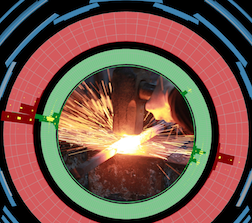Neutrino oscillations are described by the Hamiltonian, $H=\frac1{2E}M$ where $M\equiv$diag$(0,\Delta m^2_{21},\Delta m^2_{31})$ and $\Delta m^2_{ij}\equiv m^2_i-m^2_j$.
Based on solar, atmospheric, and now reactor neutrino data, we know that the mass basis is very different from the flavor basis.
The two can be related by the unitary PMNS matrix, $U$, which is a function of three mixing...
Coherent elastic neutrino-nucleus scattering (CE𝜈NS) is a long-standing prediction of the Standard Model. The possibility exists that new ultra-low energy threshold Si and Ge detectors will soon be able to observe the CE𝜈NS process with large statistics, potentially opening a new mode for probing neutrino physics and astrophysics beyond the Standard Model. This presentation will adopt the...
Understanding the charged current quasielestic (CCQE) neutrino-nucleus interaction is important for precision studies of neutrino oscillations. The theoretical description of the interaction depends on the combination of a nuclear model with the knowledge of form factors. While the former has received considerable attention, the latter, in particular the axial form factor, is implemented using...
We are entering a new era of neutrino astronomy with the recent IceCube discovery of high-energy astrophysical neutrinos. Important questions, such as what their sources are, arise with these events. The flavor composition of these neutrinos has been identified as a rich observable, containing information about the production processes and neutrino properties. So far, only νμ charged current...
There are two important missing pieces in the standard three neutrino oscillation framework: The neutrino mass ordering and to establish whether there is CP violation in the leptonic sector. Future neutrino oscillation facilities are being planned to finally determine both unknowns. At the same time, new physics in the form of Non-Standard neutrino Interactions (NSI) can be probed in...
We perform a model-independent analysis of the possible residual Klein and generalized CP symmetries associated with arbitrary lepton mixing angles in the case that there are three light Majorana neutrino species. This approach emphasizes the unique role of the Majorana phases and provides a useful framework in which to discuss the origin of the Dirac CP phase in scenarios with spontaneously...
We construct a model with three twin neutrinos in light of the neutrino appearance excesses at LSND and MiniBooNE. The model, which includes a twin parity, naturally predicts identical lepton Yukawa structures in the Standard Model and the twin sectors. As a result, a universal mixing angle controls all three twin neutrino couplings to the Standard Model charged leptons. This mixing angle is...
We revisited the theoretical implications of the study of the
so-called $D$-coefficient which is a P-conserving and T-violating
correlation in the polarized neutron beta decay. While existing
literature argued that any operator that generates this coefficient
will inevitably generate various electric dipole moments in loop
level and the latter set a much stringent bound than the...
